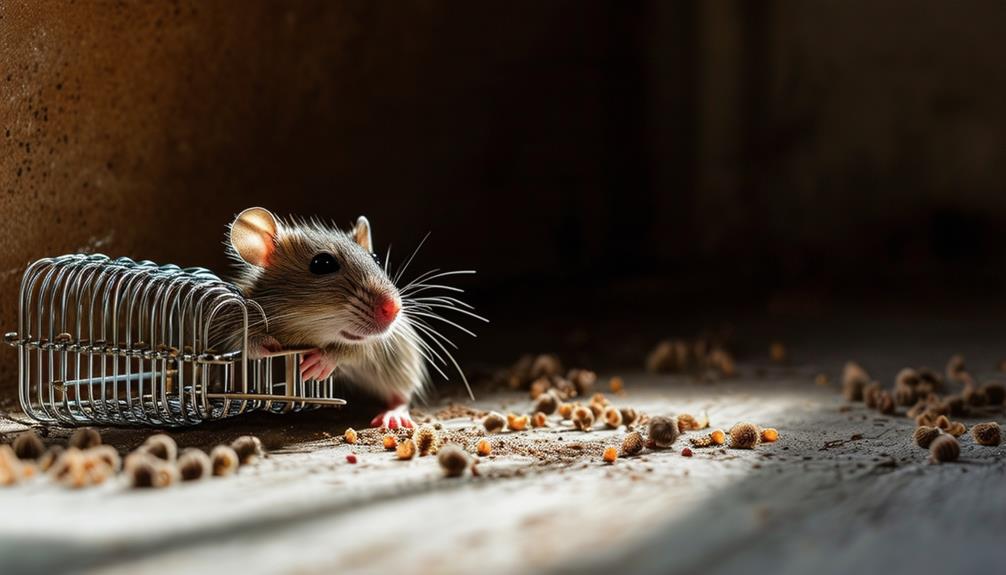When setting up rodent traps in your home, have you ever wondered about the science behind their effectiveness? Understanding how these traps work and why they are designed the way they are can greatly impact their success rate. From the intricacies of rodent behavior to the mechanics of trap mechanisms, each aspect plays an essential role in outsmarting these elusive creatures. So, next time you go to set a trap, consider delving deeper into the fascinating world of rodent control science to increase your chances of a successful catch.
Key Takeaways
- Snap traps utilize spring-loaded mechanisms for swift and humane rodent capture.
- Trap triggers are designed to be highly sensitive for efficient rodent control.
- Understanding rodent behavior aids in trap design and placement for effectiveness.
- Mimicking natural rodent instincts with trap features enhances capture rates.
- Regular monitoring, adjustment, and strategic placement optimize trap performance.
Rodent Behavior and Biology
When considering effective rodent traps, understanding the intricate behaviors and biology of rodents is essential to effectively address infestations. Rodents, being small mammals with keen senses of smell, taste, and touch, are attracted to various types of traps commonly used in pest control. Snap traps, glue traps, and live traps are some trap types designed to target these creatures. Rodents’ adaptability and neophobic tendencies make selecting the right trap critical for success in trapping them.
Given rodents’ prolific breeding habits, it’s important to act swiftly and decisively when setting up traps to control infestations effectively. Their gnawing behaviors, beyond being a nuisance, can also cause significant damage to property and food supplies. Therefore, choosing the appropriate trap type that aligns with their behaviors and biology is key to successful pest management. By being strategic in trap placement and selection, you can efficiently address rodent infestations and minimize their impact on your surroundings.
Mechanisms of Snap Traps
Snap traps operate by utilizing a spring-loaded mechanism to swiftly capture rodents. The spring within a snap trap stores potential energy, which is released when the trap is triggered. These traps are designed with trigger mechanisms that are highly sensitive to even the slightest touch from rodents. This sensitivity guarantees that the trap is triggered effectively when a rodent interacts with it. Snap traps are widely considered one of the most humane and efficient methods for rodent control. When properly set, these traps can deliver a swift and humane death to the captured rodents.
| Snap Traps | Spring-Loaded Mechanism | Humane |
|---|---|---|
| Utilize springs | Store potential energy | Effective |
| Sensitive triggers | Swiftly capture rodents | Efficient |
| Considered humane | Deliver quick death | Rodent control |
Understanding the mechanics and design of snap traps can help users effectively implement them in rodent control strategies while ensuring a humane approach to dealing with unwanted pests.
Live Capture Trap Functionality
In rodent control strategies, Live Capture Traps provide a humane method for capturing rodents alive without causing harm. These traps are specifically designed to trap rodents without injuring them. Live capture traps operate by utilizing mechanisms that trigger when a rodent enters, guaranteeing safe capture. Once the rodent is trapped, individuals have the option to release them back into the wild or relocate them to a more suitable environment.
This approach is considered more humane as it prevents unnecessary suffering for the live animals trapped. By effectively trapping rodents without causing harm, live capture traps offer a compassionate solution to dealing with unwanted pests. Their ability to trap rodents without causing unnecessary suffering makes them a popular choice for those seeking a humane method of rodent control. Remember, when using live capture traps, it’s important to check them regularly to make sure that any trapped rodents are promptly released.
Strategic Trap Placement
For maximum effectiveness in rodent control, strategic placement of traps is essential for capturing rodents efficiently. Identifying high-traffic rodent areas is vital when deciding where to position traps. Placing traps along walls and near entry points greatly increases the chances of trapping rodents as they tend to follow these pathways.
Understanding rodent behavior and movement patterns can provide valuable insights into where to strategically place traps. By utilizing multiple traps in a grid pattern, you can cover more ground and enhance trapping success. This approach allows you to target different areas simultaneously, increasing the likelihood of capturing rodents.
It’s important to regularly monitor and adjust trap placement based on rodent activity to optimize trapping outcomes. By being strategic and observant in trap placement, you can effectively control rodent populations in your environment.
Mimicking Natural Rodent Behaviors
When arranging traps, it’s vital to contemplate mimicking natural rodent behaviors. Understanding how rodents move, feed, and nest can greatly influence the success of your trapping efforts.
Natural Behavior Mimicry
Mimicking natural rodent behaviors in trap designs can greatly enhance their efficacy and capture rates. Understanding how rodents interact with their natural environment, such as exploring, foraging, and seeking shelter, is essential when designing traps.
By incorporating elements that replicate rodents’ natural behaviors, trap mechanisms can attract them more effectively. For example, traps mimicking food acquisition or scent trails that rodents follow are more likely to succeed. Additionally, creating pathways resembling those in rodents’ natural habitats can lead them into traps successfully.
Rodent Movement Patterns
To effectively mimic natural rodent behaviors in trap designs, understanding rodent movement patterns is essential for enhancing capture rates and control measures. When designing traps, consider the following:
- Rodent movement patterns mimic natural behaviors like exploring, foraging, and seeking shelter.
- Understanding these behaviors helps in designing traps that appeal to rodents’ instincts.
- Trap placement in areas where rodents typically travel or hide enhances capture success.
- Mimicking rodent movement paths and using attractants can increase trap effectiveness.
Instinct-Driven Trap Design
Understanding rodent instincts is essential when designing traps that effectively capture and control these pests. By mimicking natural rodent behaviors, trap effectiveness can be greatly enhanced. Rodents exhibit behaviors such as exploration, nesting, and food-seeking, which can be leveraged in trap design. Features like dark, enclosed spaces, nesting materials, and food attractants can appeal to these instincts, increasing the likelihood of rodents interacting with traps. Aligning trap designs with rodent instincts improves the chances of successful capture and control.
| Trap Features | Rodent Behaviors | Trap Effectiveness |
|---|---|---|
| Dark, enclosed spaces | Nesting behavior | Increased |
| Nesting materials | Nesting behavior | Enhanced |
| Food attractants | Food-seeking behavior | Improved |
Ensuring Successful Capture
To guarantee successful capture when dealing with rodents, focus on selecting the right bait, such as peanut butter or chocolate, to attract them effectively.
Placing traps strategically along their pathways and checking them regularly for activity will greatly increase your chances of catching the pests.
Understanding the behavior of the specific rodent species you’re dealing with can also help you optimize trap placement for better results.
Bait Selection Tips
For successful rodent capture, carefully selecting bait that aligns with the target species’ preferences is crucial. When dealing with house mice, opt for bait like peanut butter that appeals to their taste buds.
To guarantee the effectiveness of your traps, follow these bait selection tips:
- Use small amounts of bait to prevent rodents from feeding without triggering the trap.
- Rotate bait options to maintain rodents’ interest and increase trap effectiveness.
- Place bait at the trigger point of the trap to ensure rodents fully engage with the mechanism.
- Avoid touching bait with bare hands to minimize human scent and enhance attraction for rodents.
Placement Strategies
When setting up your rodent traps, strategically placing them along known pathways or entry points is crucial to maximizing the chances of a successful capture. Look for signs of rodent activity like droppings, gnaw marks, or grease smudges near walls or corners.
Make sure to position traps parallel to walls or baseboards, as rodents prefer to travel along edges. Placing traps in hidden areas where rodents feel secure, such as behind furniture or in dark corners, increases trapping efficiency.
Guarantee traps aren’t easily accessible to children or pets by securing them with a metal bar or placing them in enclosed bait stations. Using attractants like food or nesting materials near traps can entice rodents to enter and trigger the trap.
Regularly check and adjust trap placement based on rodent activity patterns for best results.
Minimizing Rodent Suffering
In minimizing rodent suffering, prioritizing the use of quality snap traps is essential for guaranteeing instant and humane killing, thereby reducing their pain and distress. When considering rodent control methods, it’s vital to choose options that prioritize the well-being of the animals involved. Here are four key points to keep in mind:
- Quality Snap Traps: Opt for snap traps over glue traps or rodenticides to minimize suffering. Snap traps provide a quick and humane death for rodents.
- Avoid Rodenticides: While rodenticides are effective, they lead to slow and painful deaths for rodents, making them inhumane choices for pest control.
- Say No to Glue Traps: Glue traps are considered one of the cruelest methods as they subject rodents to prolonged suffering before eventual death.
- Responsible Disposal: Dispose of trapped rodents promptly and humanely to prevent unnecessary harm and ensure ethical treatment. Remember, treating rodents inhumanely can have legal consequences.
Frequently Asked Questions
How Does a Mouse Trap Work Scientifically?
When setting a mouse trap, you might think it’s just bait and a snap, but the mechanical advantage leverages potential energy into kinetic force. The bait attraction lures them in, and force application swiftly catches them.
How Effective Are Rodent Traps?
When setting up rodent traps, consider trap efficiency by understanding rodent behavior. Place traps strategically, use bait effectively, and make sure regular maintenance. Improving these factors can boost your chances of successfully trapping rodents in various environments.
How Do Rodent Traps Work?
To understand how rodent traps work, consider rodent behavior, trap mechanisms, and animal psychology. Springs, levers, and triggers are key elements. The stored energy in springs is released upon activation, efficiently capturing rodents.
What Is the Success Rate of Rat Traps?
When setting rat traps, remember that success rates vary depending on design, bait, and placement. Properly set traps can yield catch rates between 30% to 70%. Quality traps with effective triggers can improve results.





